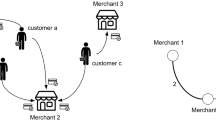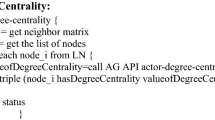Abstract
In order to track the loan lost-linking customers, we analyzed their historical daily consumption transaction network records (DCTNR), which include bank card transaction records, third-party payment transaction records, and network trading system order details records. We extracted the transaction date, time and address information from their daily consumption transaction path, analyzed the key factors affecting the tracking work, and constructed loan lost-linking customer path correlated index model which is applied to quantify the correlation between the initial search address and other addresses. In addition, we also establish loan customer daily consumption transaction network based on big data environment, propose the network sorting rules and searching rules, and construct the network sorting search algorithm to track loan lost-linking customers in different address types. In the case study, we analyzed the historical DCTNR data of a Chinese bank’s loan lost-linking customer, and applied loan lost-linking customer path correlated index model and network sorting search algorithm to track him in big data environment. The results represent that the method can achieve the purpose of tracking, and the tracking time and cost can be reduced by using network sorting rules and searching rules. It is of great practical significance and scientific guiding significance for banks, financial institutions and major financial platforms to apply big data, artificial intelligence and other information technologies to track loan lost-linking customers and recover economic losses.





Similar content being viewed by others
Explore related subjects
Discover the latest articles, news and stories from top researchers in related subjects.References
Au WH, Chan Keith CC (2003) Mining fuzzy association rules in a bank-account database. IEEE Trans Fuzzy Syst 11(2):238–248. https://doi.org/10.1109/TFUZZ.2003.809901
Barone G, Felici R, Pagnini M (2011) Switching costs in local credit markets. Int J Ind Organ 29(6):694–704. https://doi.org/10.1016/j.ijindorg.2011.03.004
Wang G, Tang Y, Xie C, Chen S (2019) Is bitcoin a safe haven or a hedging asset? Evidence from China. J Manage Sci Eng 4(3):173–188. https://doi.org/10.1016/j.jmse.2019.09.001
Liu S, Cheng T, Wang H (2020) Effects of attention and reliability on the performance of online medical crowdfunding projects: the moderating role of target amount. J Manage Sci Eng 5(3):162–171. https://doi.org/10.1016/j.jmse.2020.08.004
Huang D, Zhou J, Wang H (2018) RFMS method for credit scoring based on bank card transaction data. Stat Sin. https://doi.org/10.5705/ss.202017.0043
Somasundaram A, Reddy S (2019) Parallel and incremental credit card fraud detection model to handle concept drift and data imbalance. Neural Comput Appl 31:3–14. https://doi.org/10.1007/s00521-018-3633-8
Clerkin N, Hanson A (2020) Debit card incentives and consumer behavior: evidence using natural experiment methods. J Financ Serv Res. https://doi.org/10.1007/s10693-020-00342-9
Cabedo Semper JD, Tirado Beltrán JM (2011) Sector concentration risk: a model for estimating capital requirements. Math Comput Model 54(7–8):1765–1772. https://doi.org/10.1016/j.mcm.2010.11.086
Bhanot D, Bapat V (2015) Sustainability index of micro finance institutions (MFIs) and contributory factors. Int J Soc Econ 42(4):387–403. https://doi.org/10.1108/IJSE-01-2014-0001
Pace RK, Zhu S (2015) Inferring price information from mortgage payment behavior: a latent index approach. J Real Estate Finance Econ 53(2):246–267. https://doi.org/10.1007/s11146-015-9536-x
Nguyen T, Suardi S, Zhao J (2020) Employee treatment and bank default risk during the credit crisis. J Financ Serv Res. https://doi.org/10.1007/s10693-020-00343-8
Gonzalez Fernandez M, Gonzalez Velasco C (2020) A sentiment index to measure sovereign risk using google data. Int Rev Econ Financ 69(9):406–418. https://doi.org/10.1016/j.iref.2020.05.011
Mollmann J, Buchholz M, Kolle W, Musshoff O (2020) Do remotely-sensed vegetation health indices explain credit risk in agricultural microfinance? World Dev 127:104771. https://doi.org/10.1016/j.worlddev.2019.104771
Hartman-Glaser B, Hebert B (2020) The insurance is the lemon: failing to index contracts. J Finance 75(1):463–506. https://doi.org/10.1111/jofi.12856
Mileris R, Boguslauskas V (2010) Data reduction influence on the accuracy of credit risk estimation models. Inzinerine Ekonomika-Eng Econ 21(1):5–11
Li X, Shang Y, Su Z (2015) Semiparametric estimation of default probability: evidence from the prosper online credit market. Econ Lett 127(2):54–57. https://doi.org/10.1016/j.econlet.2014.11.033
Gastelum Chavira DA, Leyva Lopez JC, Solano Noriega JJ, Valenzuela OA, Alvarez Carrillo PA (2017) A credit ranking model for a parafinancial company based on the ELECTRE-III method and a multiobjective evolutionary algorithm. Appl Soft Comput 60(11):190–201. https://doi.org/10.1016/j.asoc.2017.06.021
Ignatius J, Hatami-Marbini A, Rahman A, Dhamotharan L, Khoshnevis P (2016) A fuzzy decision support system for credit scoring. Neural Comput Appl 29:921–937. https://doi.org/10.1007/s00521-016-2592-1
Zhou J, Li W, Wang J, Ding S, Xia C (2019) Default prediction in P2P lending from high-dimensional data based on machine learning. Physica A. https://doi.org/10.1016/j.physa.2019.122370
Shi B, Chi G, Li W (2020) Exploring the mismatch between credit ratings and loss-given-default: a credit risk approach. Econ Model 85(2):420–428. https://doi.org/10.1016/j.econmod.2019.11.032
Pang S, Xian H, Li R (2020) A default penalty model based on C2VP2C mode for internet financial platforms in Chinese market. Electron Commer Res. https://doi.org/10.1007/s10660-020-09436-x
Noh HY, Lee JH, Oh SW, Hwang KS, Cho SB (2012) Exploiting indoor location and mobile information for context-awareness service. Inf Process Manage 48(1):1–12. https://doi.org/10.1016/j.ipm.2011.02.005
Lian L, Liu A, Lau VKN (2019) User location tracking in massive mimo systems via dynamic variational bayesian inference. IEEE Trans Signal Process 67(21):5628–5642. https://doi.org/10.1109/TSP.2019.2943226
Zhou M, Tian Z, Xu K, Yu X, Hong X, Wu H (2014) SCaNME: Location tracking system in large-scale campus Wi-Fi environment using unlabeled mobility map. Expert Syst Appl 41(7):3429–3443. https://doi.org/10.1016/j.eswa.2013.10.047
Malar ACJ, Kousalya G, Ma MD (2019) Markovian model based indoor location tracking for Internet of Things (IoT) applications. Clust Comput 22:11805–11812. https://doi.org/10.1007/s10586-017-1494-z
Chen G, Viana AC, Fiore M, Sarraute C (2019) Complete trajectory reconstruction from sparse mobile phone data. EPJ Data Sci. https://doi.org/10.1140/epjds/s13688-019-0206-8
Li F, Wang X, Niu B, Li H, Li C, Chen L (2020) Exploiting location-related behaviors without the GPS data on smartphones. Inform Sci 527:444–459. https://doi.org/10.1016/j.ins.2019.05.052
Pang S, Yuan J (2020) A circulation search method of relationship closeness for criminals and loan loss-linking person based on mobile social network. Patent, CN202010186394.X. (In Chinese)
Misra S, Rajesh G (2011) Bird flight-inspired routing protocol for mobile ad hoc networks. ACM Trans Autonom Adapt Syst. https://doi.org/10.1145/2019591.2019594
Acknowledgements
This research was supported by the National Natural Science Foundation of China under Grant No. 91646112.
Author information
Authors and Affiliations
Contributions
SP Conceptualization, Data curation, Methodology, Formal analysis, Investigation, Writing—original draft, Writing—review &editing, Validation. JW Conceptualization, Data curation, Methodology, Formal analysis, Writing—original draft, Investigation,Visualization,Validation. XY Formal analysis, Investigation.
Corresponding author
Ethics declarations
Conflict of interest
The authors declare that they have no known competing financial interests or personal relationships that could have appeared to influence the work reported in this paper.
Additional information
Publisher's Note
Springer Nature remains neutral with regard to jurisdictional claims in published maps and institutional affiliations.
Rights and permissions
About this article
Cite this article
Pang, S., Wang, J. & Yi, X. Application of loan lost-linking customer path correlated index model and network sorting search algorithm based on big data environment. Neural Comput & Applic 35, 2129–2156 (2023). https://doi.org/10.1007/s00521-022-07189-2
Received:
Accepted:
Published:
Issue Date:
DOI: https://doi.org/10.1007/s00521-022-07189-2




